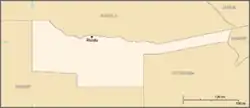Kavangoland
Kavangoland was a bantustan in South West Africa (present-day Namibia), intended by the apartheid government to be a self-governing homeland for the Kavango people. After the legal framework was established in 1968 as the Development of Self-Government for Native Nations in South-West Africa Act, 1968 (Act No. 54 of 1968),[1] Kavangoland was set up in 1970 and self-government was granted in 1973. The Kavango Legislative Council had its administrative headquarters in Rundu; its first session opened in October 1970 in the presence of the South African Minister for Bantu Administration and Development.
Kavangoland | |||||||||
|---|---|---|---|---|---|---|---|---|---|
| 1970–1989 | |||||||||
 Flag | |||||||||
 Map of the bantustan. | |||||||||
| Status | Bantustan | ||||||||
| Capital | Rundu | ||||||||
| History | |||||||||
• Established | 1970 | ||||||||
• Re-integrated into Namibia | May 1989 | ||||||||
| Currency | South African rand | ||||||||
| |||||||||

Kavangoland, like other homelands in South West Africa, was abolished in May 1989 at the start of the transition to independence.
Sebastian Kamwanga, Hompa (king) of the Gciriku and member of the Democratic Turnhalle Alliance (DTA) was the political representative of Kavangoland from 1981 to 1989.[2]
References
- "Development of Self-Government for Native Nations of South-West Africa Act, No. 54 of 1968 Republic of South Africa, 1968" (PDF).
- Shampapi, Shiremo (13 May 2011). "Sebastian Kamwanga: A Charismatic and diplomatic Hompa". New Era. Archived from the original on 12 January 2013.